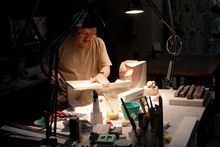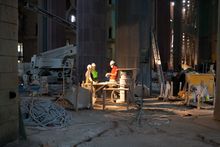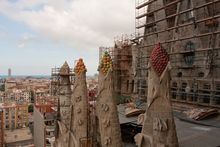Sagrada Família
| Sagrada Familia | |
|---|---|
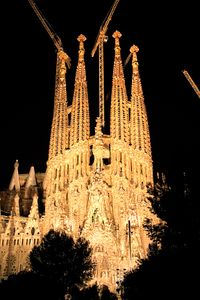
Sagrada Familia Nativity façade by night (March 2006) |
|
| Basic information | |
| Location | Barcelona, Catalonia, Spain |
| Affiliation | Roman Catholic |
| Leadership | Archbishop Lluís Martínez Sistach |
| Website | www.sagradafamilia.cat |
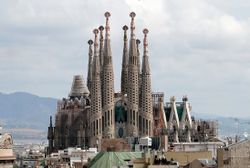
The Temple Expiatori de la Sagrada Família (official Catalan name; Spanish: Templo Expiatorio de la Sagrada Familia; "Expiatory Church of the Holy Family"), often simply called the Sagrada Família, is a massive, privately-funded Roman Catholic church that has been under construction in Barcelona, Catalonia, Spain since 1882 and is not expected to be complete until at least 2026. A portion of the building's interior is scheduled to open for public worship and tours by September 2010.[1]
Considered the master-work of renowned Spanish architect Antoni Gaudí (1852–1926), the project's vast scale and idiosyncratic design have made it one of Barcelona's (and Spain's) top tourist attractions for many years. The church is to be consecrated by Pope Benedict XVI on November 7, 2010, during his visit to Santiago de Compostela and Barcelona.[2]
Contents |
Construction history
The Sagrada Familia was designed by Antoni Gaudí (1852–1926), who worked on the project from 1883 and devoted the last fifteen years of his life entirely to the endeavour. In 1882, prior to Gaudí's involvement, Francesc del Villar was commissioned to design a church on the site. He resigned a year later and Gaudí was appointed the project architect, redesigning the project entirely. The project is scheduled to be completed in 2026. On the subject of the extremely long construction period, Gaudí is said to have remarked, "My client is not in a hurry." After Gaudí's death in 1926, work continued under the direction of Domènech Sugranyes until interrupted by the Spanish Civil War in 1936. Parts of the unfinished barn and Gaudí's models and workshop were destroyed during the war by Catalan anarchists. The present design is based on reconstructed versions of the lost plans as well as on modern adaptations. Since 1940 the architects Francesc Quintana, Isidre Puig Boada, Lluís Bonet i Gari and Francesc Cardoner have carried on the work. The illumination was designed by Carles Buigas. The current director and son of Lluís Bonet, Jordi Bonet i Armengol, has been introducing computers into the design and construction process since the 1980s. Mark Burry of New Zealand serves as Executive Architect and Researcher. Sculptures by J. Busquets, Etsuro Sotoo and the controversial Josep Subirachs decorate the fantastical façades.
According to the newspaper El Periódico de Catalunya, 2.26 million people visited the partially built church in 2004, making it one of the most popular attractions in Spain. The central nave vaulting was completed in 2000 and the main tasks since then have been the construction of the transept vaults and apse. As of 2006, work concentrated on the crossing and supporting structure for the main tower of Jesus Christ as well as the southern enclosure of the central nave, which will become the Glory façade.
Recently, the Ministry of Public Works of Spain (Ministerio de Fomento) projected the construction of a tunnel for the high speed train just under where the principal façade of the temple is to be built. Although the ministry claims that the project poses no risk to the church, its engineers and architects disagree — there is no guarantee that the tunnel will not affect the stability of the building. A campaign against the AVE was begun by the Sagrada Família preservation society (Patronat de la Sagrada Família) and the neighbourhood association (AVE pel Litoral).
The construction of the church is as much part of its attraction as the church itself. Many tourists come to admire the artists and construction workers in the process of contributing to the completion of Gaudí's masterpiece.
| Pictures of the construction of the Sagrada Família | ||||||||||
|
||||||||||
Design
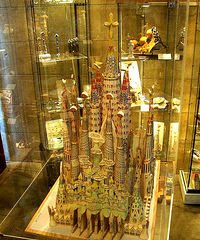
Spires
The design of La Sagrada Família is replete with Christian symbolism, as Gaudí intended the church to be the "last great sanctuary of Christendom". Its most striking aspect is its spindle-shaped spires. A total of eighteen high spires are called for, representing in ascending order of height the Twelve Apostles, the four Evangelists, the Virgin Mary and, tallest of all, Jesus Christ. According to the 2005 "Works Report" of the temple's official website, drawings signed by Gaudí, found recently in the Municipal Archives, indicate that the spire of the Virgin was in fact intended by Gaudí to be shorter than those of the evangelists, and this is the design — which the Works Report states is more compatible with the existing foundations — that will be followed. The same source explains the symbolism in terms of Christ being known through the Evangelists. The Evangelists' spires will be surmounted by sculptures of their traditional symbols: a bull (St Luke), a winged man (St Matthew), an eagle (St John), and a lion (St Mark). The central spire of Jesus Christ is to be surmounted by a giant cross; the spires's total height (170 m) will be one metre less than that of Montjuïc (a hill in Barcelona), as Gaudí believed that his work should not surpass that of God and will, when completed, make Sagrada Familia the tallest church building in the world as well as the church with the tallest spire in the world. The lower spires are surmounted by communion hosts with sheaves of wheat and chalices with bunches of grapes, representing the Eucharist.
Façades
The Church will have three grand façades: the Nativity façade to the East, the Glory façade to the South (yet to be completed) and the Passion façade to the West. The Nativity façade was built before work was interrupted in 1935 and bears the most direct Gaudí influence. The Passion façade is especially striking for its spare, gaunt, tormented characters, including emaciated figures of Christ being flogged and on the crucifix. These controversial designs are the work of Josep Maria Subirachs. The Glory Façade, which began construction in 2002, will be the largest and most monumental of the three and will represent one’s ascension to God. It will also depict various scenes such as Hell, Purgatory, and will include elements such as the Seven Deadly Sins and the Seven Virtues.
Nativity Façade
Constructed between 1894 and 1930, the Nativity Façade was the first façade to be completed. Dedicated to the birth of Jesus, it is decorated with scenes reminiscent of elements of life. Characteristic of Gaudí’s naturalistic style, the sculptures are ornately arranged and decorated with scenes and images from nature , each a symbol in their own manner. For instance, the three porticos are separated by two large columns, and at the base of each lies a turtle or a tortoise (one to represent the land and the other the sea; each are symbols of time as something set in stone and unchangeable). In contrast to the figures of turtles and their symbolism, two chameleons can be found at each sides of the façade, and are symbolic of change.
The façade faces the rising sun to the northeast, a symbol for the birth of Christ. It is divided into three porticos, each of which represents a theological virtue (Hope, Faith and Charity). The Tree of Life rises above the door of Jesus in the portico of Charity. Four towers complete the façade and are each dedicated to a Saint (Matthias the Apostle, Saint Barnabas, Jude the Apostle, and Simon the Zealot).
Originally, Gaudí intended for this façade to be polychromed, for each archivolt to be painted with a wide array of colors. He wanted every statue and figure to be painted. In this way the figures of humans would appear as much alive as the figures of plants and animals.[3]
Gaudí chose this façade to embody the structure and decoration of the whole temple. He was well aware that it would not be him that would finish the temple and that he would need to set an artistic and architectural example for others to model after. He also chose for this façade to be the first to begin construction and for it to be, in his opinion, the most attractive and accessible to the public. He believed that if he had began construction of the Passion Façade, one that would be hard and bare, as if made with bones, before the Nativity Façade, people would have withdrawn at the sight of it.[4]
Passion Façade
In contrast to the highly decorated Nativity Façade, the Passion Façade is austere, plain and simple, with ample bare stone, and is carved with harsh straight lines to resemble a skeleton if it were reduced to only bone. Dedicated to the Passion of Christ, the suffering of Jesus during his crucifixion, the façade was intended to portray the sins of man. Construction began in 1954, following the drawings and instructions left by Gaudí for future architects and sculptors. The towers were completed in 1976, and in 1987 a team of sculptors, headed by Josep Maria Subirachs, began work sculpting the various scenes and details of the façade. They aimed to give a rigid, angular form to provoke a dramatic effect. Gaudi intended for this façade to strike fear into the onlooker. He wanted to “break” arcs and “cut” columns, and to use the effect of chiaroscuro (dark angular shadows contrasted by harsh rigid light) to further show the severity and brutality of Christ’s sacrifice.
Facing the setting sun, indicative and symbolic of the death of Christ, the Passion Façade is supported by six large and inclined columns, designed to resemble sequoia trunks. Above there is a pyramidal pediment, made up of 18 bone-shaped columns, which culminate in a large cross with a crown of thorns. Each of the four towers is dedicated to an apostle (James, Thomas, Philip, or Bartholomew) and, like the Nativity Façade, there are three porticos, each representing the theological virtues, though in a much different light.
The scenes sculpted into the façade may be divided into three levels, which ascend in an S form and reproduce the Calvary, or Golgotha, of Christ.[5] The lowest level depicts scenes from Jesus’ last night before the crucifixion, including The Last Supper, Kiss of Judas, Ecce Homo, and the Sanhedrin Trial of Jesus. The mid level portrays the Calvary, or Golgotha, of Christ, and includes The Three Marys, Saint Veronica, and Saint Longinus. In the third and final level we can see the Death, Burial and the Resurrection of Christ. A bronze figure of Jesus situated on a bridge linking the towers of Saint Bartholomew and Saint Thomas, represents The Ascension of Jesus.[6]
Glory Façade
The largest and most striking of the facades will be the Glory Façade, which began construction in 2002. It will be the principal façade and will offer access to the central nave. Dedicated to the Celestial Glory of Jesus, it represents the road to God: Death, Final Judgment, and Glory, while Hell is left for those who deviate from God’s will. Aware that he would not live long enough to see this façade completed, Gaudí made only a general sketch of what the façade would look like. He intended for the temple, like many cathedrals and facades throughout history, to be completed not only by other architects, but also to incorporate others architectural and artistic styles.[7]
To reach the Glory Portico, there will be a large staircase, which will create an underground passage beneath Mallorca Street, representing Hell and vice. It will be decorated with demons, idols, false gods, heresy and schisms, etc. Purgatory and death will also be depicted, the latter using tombs along the ground. The portico will have seven large columns dedicated to spiritual gifts. At the base of the columns there will be representations of the Seven Deadly Sins, and at the top, The Seven Virtues.
Interior

The church plan is that of a Latin cross with five aisles. The central nave vaults reach forty-five metres while the side nave vaults reach thirty metres. The transept has three aisles. The columns are on a 7.5 metre grid. However, the columns of the apse, resting on del Villar's foundation, do not adhere to the grid, requiring a section of columns of the ambulatory to transition to the grid thus creating a horseshoe pattern to the layout of those columns. The crossing rests on the four central columns of porphyry supporting a great hyperboloid surrounded by two rings of twelve hyperboloids (currently under construction). The central vault reaches sixty metres. The apse will be capped by a hyperboloid vault reaching seventy-five metres. Gaudí intended that a visitor standing at the main entrance be able to see the vaults of the nave, crossing, and apse, thus the graduated increase in vault loftiness.
The columns of the interior are a unique Gaudí design. Besides branching to support their load, their ever-changing surfaces are the result of the intersection of various geometric forms. The simplest example is that of a square base evolving into an octagon as the column rises, then a sixteen-sided form, and eventually to a circle. This effect is the result of a three-dimensional intersection of helicoidal columns (for example a square cross-section column twisting clockwise and a similar one twisting counter-clockwise).
Geometric details

The towers on the Nativity façade are crowned with geometrically shaped tops that are reminiscent of Cubism (they were finished around 1930), and the intricate decoration is contemporary to the style of Art Nouveau, but Gaudí's unique style drew primarily from nature, not other artists or architects, and resists categorization.
Gaudí used hyperboloid structures in later designs of the Sagrada Família (more obviously after 1914), however there are a few places on the nativity façade—a design not equated with Gaudí's ruled-surface design, where the hyperboloid crops up. For example, all around the scene with the pelican there are numerous examples (including the basket held by one of the figures). There is a hyperboloid adding structural stability to the cypress tree (by connecting it to the bridge). And finally, the "bishop's mitre" spires are capped with hyperboloid structures[8]. In his later designs, ruled surfaces are prominent in the nave's vaults and windows and the surfaces of the Passion facade.
Symbolism
Themes throughout the decoration include words from the liturgy. The towers are decorated with words such as "Hosanna", "Excelsis", and "Sanctus"; the great doors of the Passion façade reproduce words from the Bible in various languages including Catalan; and the Glory façade is to be decorated with the words from the Apostles' Creed.
Areas of the sanctuary will be designated to represent various concepts, such as saints, virtues and sins, and secular concepts such as regions, presumably with decoration to match.
Burials
Current status
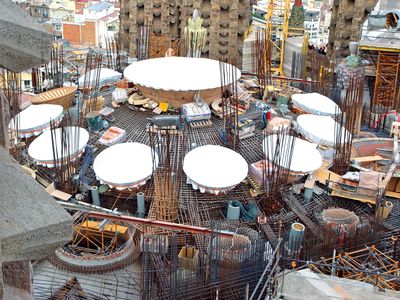
The building works are expected to be completed around 2026, the 100th anniversary of Gaudí's death, although the likelihood of meeting this date is disputed. Computer Aided design technology has been used to speed up the construction of the building; initially, the construction work was expected to last for several hundred years, based on building techniques available in the early 1900s. The new technology allows each block of stone to be shaped off-site by a CNC milling machine, whereas in the 1900s, the stone was carved by hand.[9] The best description of the current means of construction and future plans is in a catalogue in an exhibition at the Deutsches Architekturmuseum Frankfurt am Main.[10]
The current information leaflet estimates a completion date in 2017. The accelerated construction has been aided by additional funding from visitors since the popularity of Barcelona as a tourist city following the 1992 Barcelona Olympics.
Some renowned Catalan architects advocate a construction halt,[11] to respect Gaudí's original designs (which were not exhaustive, were partially destroyed, and have been partially reconstructed in recent years).[10]
The church is scheduled to open for worship by September 2010[1]. Later on November 7 the Pope is scheduled to consecrate the temple.[2]
Visiting
Visitors can go into the Nave, Crypt, Museum, Shop and up the Passion and Nativity towers. An entry fee of €12 for adults, €10 for students, and €8 for children is payable for the Nave, Crypt, Museum, and Shop. Access to the towers (Nativity Façade and Passion Façade) is now only possible by lift (€2.50) and then walking up the remainder of the tower, over the bridge between the towers and descent via the opposite tower by spiral staircase. Previously, visitors were able to walk up the towers for free. As of August 2010, there will be a new service of fast entering. Visitors can buy their tickets at any Servicaixa ATM (part of 'La Caixa' https://www.servicaixa.com/nav/landings/es/mucho_mas/sagrada_familia/sagrada_familia.html?loce=es-home-right-3-1-LASAGRADAFAMLIA) or servicaixa.com, they will get a code with which they are going to be allowed to enter the Temple by a fast line. The service has a fee of 1'30€ extra.
Funding
Construction on Sagrada Família is not supported by any government or official church sources. Private patrons funded the initial stages.[12] Money from tickets purchased by tourists is now used to pay for the work, and private donations are accepted through the Friends of the Temple.
The construction budget for 2009 is €18 million.[1]
Media
Gallery
 West side (cranes removed). (2009) |
.jpg) Passion façade (2004) |
.jpg) Nativity façade (2004) |
 Glory façade (2008) |
See also
- Sagrada Família (Barcelona Metro)
References
- ↑ 1.0 1.1 1.2 Montañés, José Ángel (13 March 2009). "La Sagrada Familia se abrirá al culto en septiembre de 2010" (in Spanish). El País. http://www.elpais.com/articulo/cataluna/Sagrada/Familia/abrira/culto/septiembre/2010/elpepuespcat/20090313elpcat_2/Tes. Retrieved 2009-06-19. (English tr)
- ↑ 2.0 2.1 Delaney, Sarah (4 March 2010). "Pope to visit Santiago de Compostela, Barcelona in November". Catholic News Service. http://www.catholicnews.com/data/stories/cns/1000887.htm. Retrieved 2010-07-07.
- ↑ Bergós, Gaudí, l'home i l'obra, p. 40.
- ↑ Barral Altet, Art de Catalunya. Arquitectura religiosa moderna i contemporània, p.218.
- ↑ Mª José Gómez Gimeno (2006). La Sagrada Familia. Mundo Flip Ediciones. pp. 86-87. ISBN 84-933983-4-9.
- ↑ "La Sagrada Familia abrirá al culto en 2008, según sus responsables (The Sagrada Familia opens for worship in 2008, according to its leaders)" (in Spanish). El Mundo. Europa Press (Mundinteractivos, SA). 2 June 2005. http://www.elmundo.es/elmundo/2005/06/02/cultura/1117725182.html. Retrieved 2010-07-07. (English tr.)
- ↑ Fargas, Simbología del Templo de la Sagrada Familia, p. 180.
- ↑ M.C. Burry; J.R. Burry, G.M. Dunlop & A. Maher (2001). Drawing Together Euclidean and Topological Threads. The 13th Annual Colloquium of the Spatial Information Research Centre, University of Otago, Dunedin, New Zealand. http://www.business.otago.ac.nz/SIRC05/conferences/2001/05_burry.pdf. Retrieved 2008-08-05. The paper explores the assemblies of second order hyperbolic surfaces as they are used throughout the design composition of the Sagrada Família Church building.
- ↑ Daniel, Paul (January 2009). Diamond tools help shape the Sagrada Familia(PDF). Industrial Diamond Review. Retrieved 2010-07-07.
- ↑ 10.0 10.1 Burry, Mark; Gaudí, Antoni (2007). Gaudi Unseen. Berlin: Jovis Verlag. ISBN 9783939633785.
- ↑ Fancelli, Agustí (4 December 2008). "¿Por qué no parar la Sagrada Familia? (Why not stop the Sagrada Familia?)" (in Spanish). http://www.elpais.com/articulo/cultura/parar/Sagrada/Familia/elpepicul/20081204elpepicul_4/Tes. Retrieved 2010-07-07. (English tr.)
- ↑ Fletcher, Tom. "Sagrada Familia "Church of the Holy Family"". Essential Architecture. http://www.essential-architecture.com/SPAIN/SP-BA/BA-006.htm. Retrieved 2008-08-05.
Sources
- Barral i Altet, Xavier (1999). Art de Catalunya. Arquitectura religiosa moderna i contemporània. Barcelona: L'isard. ISBN 84-89931-14-3.
- Bergós i Massó, Joan (1999). Gaudí, l'home i l'obra. Barcelona: Ed. Lunwerg. ISBN 84-7782-617-X.
- Fargas, Albert (2009). Simbología del Templo de la Sagrada Familia. Barcelona: Triangle Postals. ISBN 978-84-8478-405-0.
- Gómez Gimeno, María José (2006). La Sagrada Familia. Mundo Flip Ediciones. ISBN 84-933983-4-9.
- Schneider, Rolf (2004). Manfred Leier. ed. 100 most beautiful cathedrals of the world: A journey through five continents. trans. from German by Susan Ghanouni and Rae Walter. Edison, New Jersey: Chartwell Books. p. 33.
External links
- Sagrada Família
- Expiatory Church of the Sagrada Familia at Structurae
- Gaudí and Sagrada Família Barcelona
- Discover Wonders of the World: Sagrada Família
- Sagrada Familia at Great Buildings
|
||||||||||||||||||||||||||||
|
||||||||||||||||||||||||||||||||||||||
